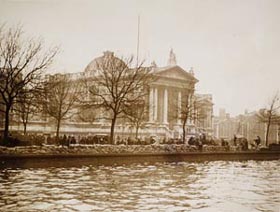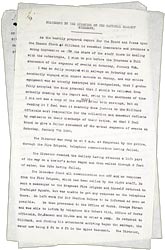|
The flood |
Rescue work |
Extent of the damage |
The aftermath
The flood

On 7 January 1928, Tate was hit by one of the worst disasters in its history, when its lower galleries were flooded.
On the following pages you can explore what happened using original photographs and documents.
What caused the flood?

Christmas 1927 saw heavy falls of snow in the Cotswolds where the River Thames has its source.
In early January 1928, a sudden thaw doubled the volume of water flowing down the Thames and this, coupled with violent storms, lead to the disaster.
When the tide turned on January 6 it surged back upstream pummelling the river banks. |

Thames flood waters
© Tate Archive 2003 |
 |
In the early hours of January 7 the embankment wall collapsed near Lambeth Bridge, right opposite the Tate.
Flood water poured across the road destroying homes and forcing local residents to swim for their lives - 14 people were unable to escape and drowned.
The water roared into the lower galleries of the Tate, reaching depths of between 5 and 8 feet.
The Director, Charles Aitken, was told of the disaster at 5am and rushed to the Gallery to supervise the emergency proceedings.
In his report on the flood, which we have included here, he recounts the difficulties he had reaching the Gallery, travelling partway on a grocer's
wagon and then struggling through 2 feet of water, as the 'Tube' had failed.
 Director's statement on the flood
Director's statement on the flood
© Tate Archive 2003 |
|
